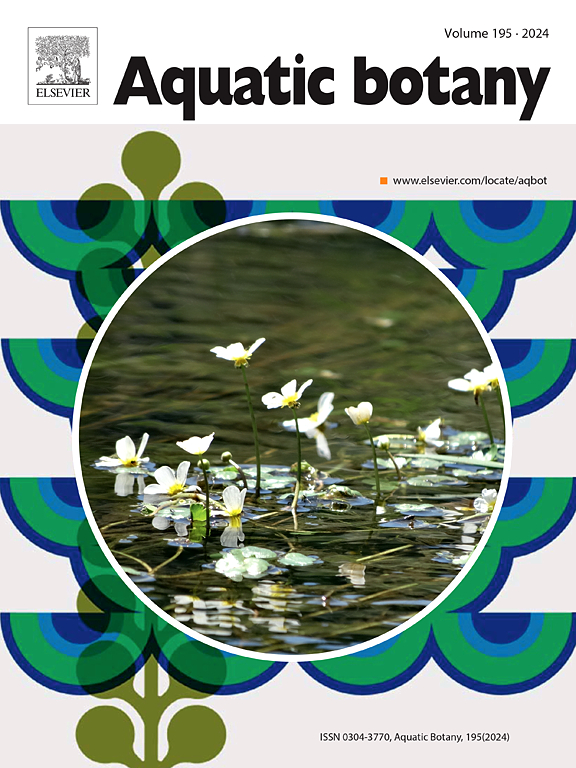Morphological and physiological traits of two closely related charophyte species: Chara virgata Kütz. and C. globularis Thuill.
IF 2.6
4区 生物学
Q2 MARINE & FRESHWATER BIOLOGY
引用次数: 0
Abstract
Charophytes (Charophyceae) are submerged macrophytes that play an important ecological role. They provide food and shelter and consequently are often used as bioindicators for water quality. However, species identification remains challenging due to purported broad morphological plasticity. This study investigates the morphological, physiological, and pigment-based acclimation behaviour of Chara virgata Kütz. and Chara globularis Thuill. under controlled light and temperature conditions in order to clarify which traits can be used for species identification. Chara virgata exhibited relatively stable morphological traits across all conditions, with photosynthetic responses primarily driven by light availability. Depending on the prevailing light and temperature conditions, C. virgata exhibited no discernible pattern of elongation in the upper row of stipulodes. In contrast, C. globularis displayed significant morphological plasticity, elongating internodes under low-light and at higher temperatures, with pigment composition adjusting in response to temperature conditions. Moreover, the length of the upper row of stipulodes remained constant within the experimental conditions. These differences align with their respective habitat preferences. Chara virgata predominantly occurs in shallow water with large fluctuations of temperature and irradiance whereas C. globularis prefers greater depths with more stable temperature conditions. The study further demonstrates that vegetative parameters, such as stipulode length, can vary with environmental conditions, limiting their reliability for species identification. These results emphasise the need to integrate physiological traits for a robust classification of charophyte species, and reinforce the idea of including reproductive traits in the determination keys to clearly identify these two species.
两种近缘Chara virgata k tz的形态和生理特征。和C. globularis thill。
Charophytes (Charophyceae)是一种水下大型植物,具有重要的生态作用。它们提供食物和住所,因此经常被用作水质的生物指标。然而,由于广泛的形态可塑性,物种鉴定仍然具有挑战性。本研究探讨了紫叶查拉(Chara virgata k tz)的形态、生理和色素驯化行为。和球状星Chara thill。在受控的光照和温度条件下,以阐明哪些性状可用于物种鉴定。在所有条件下,柽柳都表现出相对稳定的形态特征,光合反应主要受光效的驱动。在不同的光照和温度条件下,柽柳茎柄上排没有明显的伸长规律。相比之下,C. globullaris在低光照和高温条件下表现出显著的形态可塑性,节间延长,色素成分随温度变化而调整。此外,在实验条件下,茎柄上排的长度保持不变。这些差异与它们各自的栖息地偏好有关。virgata主要发生在温度和辐照度波动较大的浅水中,而C. globularis则喜欢温度条件稳定的更深的水域。该研究进一步表明,茎叶长度等营养参数会随着环境条件的变化而变化,从而限制了它们在物种鉴定中的可靠性。这些结果强调了整合生理性状对叶藻物种分类的必要性,并加强了将生殖性状纳入确定关键的想法,以清楚地识别这两个物种。
本文章由计算机程序翻译,如有差异,请以英文原文为准。
求助全文
约1分钟内获得全文
求助全文
来源期刊

Aquatic Botany
生物-海洋与淡水生物学
CiteScore
3.80
自引率
5.60%
发文量
70
审稿时长
6 months
期刊介绍:
Aquatic Botany offers a platform for papers relevant to a broad international readership on fundamental and applied aspects of marine and freshwater macroscopic plants in a context of ecology or environmental biology. This includes molecular, biochemical and physiological aspects of macroscopic aquatic plants as well as the classification, structure, function, dynamics and ecological interactions in plant-dominated aquatic communities and ecosystems. It is an outlet for papers dealing with research on the consequences of disturbance and stressors (e.g. environmental fluctuations and climate change, pollution, grazing and pathogens), use and management of aquatic plants (plant production and decomposition, commercial harvest, plant control) and the conservation of aquatic plant communities (breeding, transplantation and restoration). Specialized publications on certain rare taxa or papers on aquatic macroscopic plants from under-represented regions in the world can also find their place, subject to editor evaluation. Studies on fungi or microalgae will remain outside the scope of Aquatic Botany.
 求助内容:
求助内容: 应助结果提醒方式:
应助结果提醒方式:


